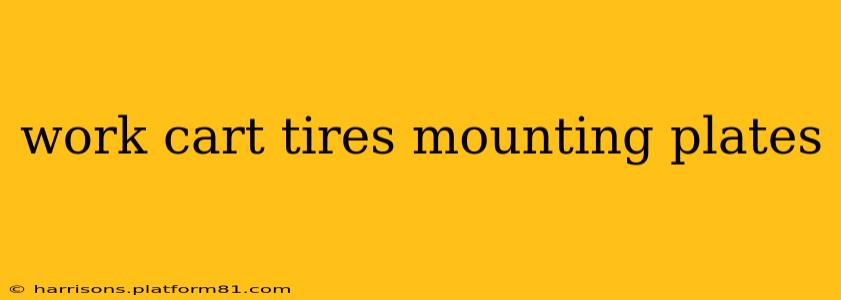Work cart tires are essential for smooth operation and longevity of your equipment. A critical component often overlooked is the mounting plate, the interface between the tire and the cart's wheel assembly. Understanding mounting plates and their role in tire installation is crucial for maintaining your work cart's efficiency and safety. This comprehensive guide delves into the world of work cart tires, focusing on mounting plates and addressing common questions.
What are Work Cart Tire Mounting Plates?
Work cart tire mounting plates are the metal or plastic components that securely fasten the tire to the wheel assembly of a work cart. They act as a robust intermediary, ensuring the tire remains firmly attached during use, preventing slippage and potential accidents. The design varies depending on the cart's construction and tire type. Some plates are simple, flat pieces, while others incorporate more complex designs for enhanced strength and durability. The material choice also impacts durability and resistance to wear and tear, with steel being a common choice for heavy-duty applications.
How do I Mount Work Cart Tires?
Mounting work cart tires typically involves the following steps:
- Preparation: Ensure you have the correct tools, including a tire iron or mounting tool, and potentially a lubricant to aid in the process. Inspect the tire and rim for any damage.
- Mounting the Tire: Carefully position the tire onto the rim, ensuring the bead (the edge of the tire) seats correctly. This often requires leverage and can be physically demanding.
- Securing the Tire: Using the appropriate mounting plate, bolt or otherwise attach the assembly to the cart's wheel hub. Ensure the bolts are tightened evenly to prevent uneven wear and tear.
- Inflation: Inflate the tire to the manufacturer's recommended pressure, as indicated on the tire sidewall.
What size mounting plate do I need for my work cart tires?
The size of the mounting plate required depends entirely on the dimensions of your work cart's wheel hub and the tire's diameter. There's no universal size. You'll need to consult the specifications for your specific work cart model or, failing that, measure the wheel hub to determine compatible mounting plate dimensions.
How often should I replace my work cart tires?
The lifespan of a work cart tire depends significantly on usage and environmental factors. Regular inspections for wear and tear, cracks, or embedded debris are essential. Consider replacing your tires when you notice significant tread wear, damage to the sidewall, or uneven wear patterns indicating potential alignment issues. A proactive approach prevents unexpected failures and ensures continued safe operation.
Are all work cart tire mounting plates the same?
No, work cart tire mounting plates are not all the same. They vary in size, material, design, and mounting mechanism. The type of mounting plate suitable for your work cart depends on the specific model and the dimensions of its wheel assembly and the tire used. Factors to consider include load capacity, material strength, and ease of installation.
What are the different types of work cart tires?
Work carts often utilize different tire types depending on the application and required load capacity. Common types include pneumatic tires (filled with air), solid rubber tires, and foam-filled tires. Pneumatic tires offer a smoother ride but require regular inflation and are prone to punctures. Solid rubber tires are puncture-proof and require less maintenance but offer a harsher ride. Foam-filled tires offer a balance between these extremes, providing a relatively smooth ride with added puncture resistance. The choice impacts the mounting plate requirements.
How do I choose the right work cart tires?
Selecting the right work cart tires depends on several factors:
- Load Capacity: Ensure the tire's load capacity exceeds the weight the cart will carry.
- Terrain: The surface the cart will traverse influences the tire type. Smooth surfaces may allow for pneumatic tires, while rough terrain might necessitate more robust options.
- Cart Design: The cart's wheel and mounting plate design will dictate the tire compatibility.
Careful consideration of these aspects ensures a suitable match, optimizing performance and longevity.
This guide aims to provide a comprehensive understanding of work cart tires and their mounting plates. Remember to always consult your cart's user manual for specific recommendations and safety precautions. Proper tire maintenance and selection contribute significantly to the efficiency, safety, and longevity of your work cart.
